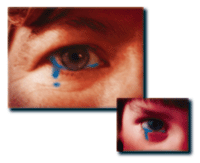Crying,
our parents tell us early on, is childish. "Use words,"
our preschool teachers exhort. But adults still cry.
 Sociologist
Jack Katz, JD'69,
studies "emotional outbursts"--from anger and shame to laughter
and crying--to untangle the complex interactions of emotions,
body, and language. We cry, Katz says, when words are not enough.
Sociologist
Jack Katz, JD'69,
studies "emotional outbursts"--from anger and shame to laughter
and crying--to untangle the complex interactions of emotions,
body, and language. We cry, Katz says, when words are not enough.
 Crying
is not just a "feeling" nor just a series of effects; it is a
subtle range of corporeal doings, such as balking at speaking,
resonant markings of pauses between utterances, and a manner of
depicting the body as too light or too heavy a vehicle to bear
or to hold on to language. If we want to understand what crying
is, we must address, as directly as possible, its distinctive
ways of doing battle with speech.
Crying
is not just a "feeling" nor just a series of effects; it is a
subtle range of corporeal doings, such as balking at speaking,
resonant markings of pauses between utterances, and a manner of
depicting the body as too light or too heavy a vehicle to bear
or to hold on to language. If we want to understand what crying
is, we must address, as directly as possible, its distinctive
ways of doing battle with speech.
The
dynamic tension between language and crying gives us an important
clue to a necessary condition of crying, whether or not talking
is involved. In order to make crying a compellingly sensible thing
to do, adults must in effect explain why they can't express themselves
in language. This necessity for warranting crying holds whether
or not anyone else will observe the person crying.
One
cries on the understanding that the situation requires a personally
embodied form of expression that transcends what language can
do.
People
cry in response to music, to pictorial art, to sunsets, and to
eclipses. These cryings honor experiences that in their nature
go beyond words. When words are present, they risk detracting
from the provocative experience. It is not what the tour guide
says about the cathedral, not what is written on the placard under
the painting, not the phrases that appear on the screen over the
opera stage that bring tears; it is something unspeakable, something
responsive to the "different keys" in which art communicates.
Attending too much to words that purport to describe an experience
can stand in the way of a resonant experience.
Where
social customs demand a respectfully silent and stationary watching,
tears often emerge as the only outlet for an irresistibly responsive
grasping of the happenings. Crying is a predictable response by
respectfully frozen guests at funerals, children's school recitals,
award shows, weddings, and patriotic ceremonies.
Events
that mark status passages, like weddings, or that mark status
elevations, like awards ceremonies, are common places for crying
by the adults who are at the center of collective attentions.
A speech act that otherwise is so simple and unproblematic as
to pass execution without any serious attention (uttering the
little words "I do," recalling the names of people one works with
every day) for once carries transcendent implications. The crying
body represents an understanding for which the commonplace words
seem inadequate.




![]()
 Sociologist
Jack Katz, JD'69,
studies "emotional outbursts"--from anger and shame to laughter
and crying--to untangle the complex interactions of emotions,
body, and language. We cry, Katz says, when words are not enough.
Sociologist
Jack Katz, JD'69,
studies "emotional outbursts"--from anger and shame to laughter
and crying--to untangle the complex interactions of emotions,
body, and language. We cry, Katz says, when words are not enough.
 Crying
is not just a "feeling" nor just a series of effects; it is a
subtle range of corporeal doings, such as balking at speaking,
resonant markings of pauses between utterances, and a manner of
depicting the body as too light or too heavy a vehicle to bear
or to hold on to language. If we want to understand what crying
is, we must address, as directly as possible, its distinctive
ways of doing battle with speech.
Crying
is not just a "feeling" nor just a series of effects; it is a
subtle range of corporeal doings, such as balking at speaking,
resonant markings of pauses between utterances, and a manner of
depicting the body as too light or too heavy a vehicle to bear
or to hold on to language. If we want to understand what crying
is, we must address, as directly as possible, its distinctive
ways of doing battle with speech.